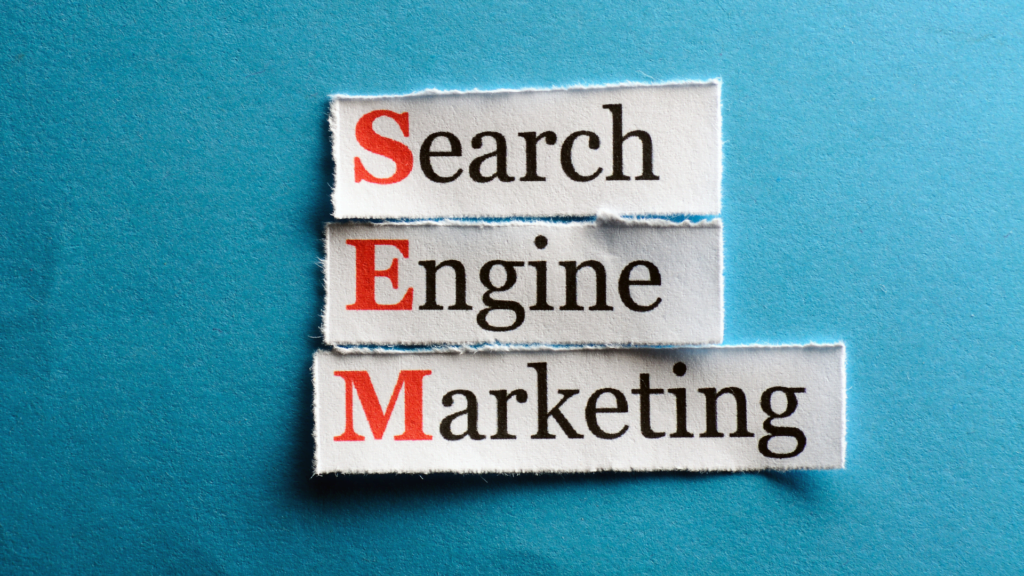Introduction
In today’s highly competitive digital environment, establishing a strong online presence is essential for businesses seeking to connect with their target audience and drive meaningful engagement. Enter Search Engine Marketing (SEM), a dynamic and multifaceted approach designed to amplify visibility and attract targeted traffic to websites through paid advertising. By leveraging Search Engine Marketing (SEM) strategies, businesses can strategically position themselves within the sponsored section of search engine results pages (SERPs), ensuring prime visibility to users actively seeking their products or services.
In this comprehensive guide, we embark on a journey through the intricacies of Search Engine Marketing (SEM), dissecting its key components and unveiling best practices that empower businesses to navigate the evolving landscape of digital marketing with confidence and precision. From the fundamental principles of PPC advertising to the nuances of keyword research, bid management, and ad optimization, we explore the tools and tactics that underpin Search Engine Marketing (SEM) success, equipping businesses with the knowledge and insights needed to harness the full potential of this powerful marketing tool.
What is Search Engine Marketing (SEM)?
Search Engine Marketing (SEM) is a digital marketing strategy aimed at increasing a website’s visibility in search engine results pages (SERPs) through paid advertising. Unlike Search Engine Optimization (SEO), which focuses on optimizing organic search visibility, SEM involves bidding on keywords relevant to a business’s offerings and creating targeted ads to appear alongside or above organic search results.
Advertisers pay a fee each time a user clicks on their ad, hence the term “pay-per-click” (PPC) advertising. SEM encompasses various components, including keyword research, ad copy creation, bid management, and landing page optimization, all working together to drive targeted traffic to a website and generate conversions. Overall, Search Engine Marketing (SEM) serves as a powerful tool for businesses looking to increase their online visibility, reach their target audience, and achieve their marketing objectives in the competitive digital landscape.
Fundamentals and Components
At its core, SEM revolves around the concept of paid search advertising, where advertisers bid on keywords relevant to their target audience. SEM primarily operates through two key components:
1. PPC (Pay-Per-Click) Advertising
PPC advertising is a model in which advertisers pay a fee each time their ad is clicked. PPC (Pay-Per-Click) advertising represents a pivotal component of digital marketing strategies, offering advertisers a precise and measurable means to connect with their target audience. By bidding on keywords aligned with their products or services, businesses vie for visibility in the highly coveted sponsored section of search engine results pages (SERPs). When users input queries matching these keywords, relevant ads are showcased, providing advertisers with a direct pathway to engage potential customers actively seeking their offerings.
The intricate dance of bid amounts and ad relevance determines ad placement, with higher bids often securing prime positions. However, the effectiveness of PPC campaigns hinges not only on bid management but also on ad quality, as search engines prioritize ads that deliver value to users. This dynamic interplay between bidding strategy and ad relevance underscores the importance of a nuanced approach to PPC advertising, where meticulous keyword selection, compelling ad copy, and ongoing optimization converge to maximize ROI and drive business growth.
2. Keyword Research and Optimization
Keyword research is the process of identifying and analyzing terms and phrases that potential customers use when searching for products or services online. Keyword research serves as the cornerstone of effective Search Engine Marketing (SEM), offering advertisers invaluable insights into the language and intent of their target audience. This multifaceted process entails not only identifying the terms and phrases most commonly used by potential customers but also delving deeper to understand the nuances of search volume, competition levels, and relevance to the business’s offerings.
Armed with this knowledge, advertisers can strategically optimize their campaigns by seamlessly integrating these keywords into various elements, including ad copy, landing pages, and bid strategies. By aligning their messaging with the language of their audience and ensuring relevance at every touchpoint, advertisers can enhance ad visibility, improve click-through rates, and ultimately drive conversions. Moreover, ongoing keyword research and refinement empower advertisers to adapt to changing market dynamics, stay ahead of competitors, and maintain a competitive edge in the ever-evolving digital landscape.
SEM Strategies and Best Practices
To maximize the effectiveness of SEM campaigns, advertisers must implement strategic approaches and adhere to best practices:
1. Campaign Structuring
Effective campaign structuring is a fundamental aspect of Search Engine Marketing (SEM), requiring meticulous organization of campaigns into cohesive and relevant ad groups. This segmentation is typically based on product or service categories, target demographics, or geographic locations, allowing advertisers to tailor their messaging and bidding strategies to specific audience segments. By grouping ads thematically, advertisers can create more targeted and personalized experiences for users, increasing ad relevance and engagement.
Furthermore, this structured approach enables advertisers to allocate budgets more efficiently, focusing resources on high-performing ad groups and optimizing campaign performance. Overall, strategic campaign structuring plays a crucial role in enhancing ad relevance, improving performance metrics, and maximizing return on investment (ROI) in SEM campaigns.
2. Ad Copy Optimization
Ad copy optimization is a critical component of Search Engine Marketing (SEM) that revolves around the creation of persuasive and resonant ad content tailored to the target audience. It involves a meticulous process of crafting compelling messaging that highlights the unique selling propositions (USPs) of a product or service while seamlessly integrating targeted keywords to enhance relevance and visibility in search results.
Furthermore, effective ad copy incorporates clear and compelling calls-to-action (CTAs) that prompt users to take desired actions, such as making a purchase, signing up for a newsletter, or requesting more information. By optimizing ad copy, advertisers can significantly improve click-through rates (CTR), enhance user engagement, and ultimately drive conversions, thereby maximizing the effectiveness of their Search Engine Marketing (SEM) campaigns.
3. Bid Management
Effective bid management strategies form the backbone of successful Search Engine Marketing (SEM) campaigns, requiring ongoing monitoring and refinement of keyword bids to ensure optimal ad placement and ROI. Advertisers utilize automated bidding tools and sophisticated algorithms to streamline this process, allowing for real-time adjustments based on various factors such as keyword performance, competitive landscape, and budget constraints.
By leveraging these tools, advertisers can maintain a competitive edge in bidding auctions, capitalize on high-performing keywords, and allocate budget resources efficiently to maximize campaign performance and achieve their desired advertising objectives within the dynamic and competitive digital advertising ecosystem.
4. Landing Page Optimization
Seamless integration between ad messaging and landing page content is essential for ensuring a cohesive user experience and driving optimal conversion rates in Search Engine Marketing (SEM) campaigns. When users click on an ad, they expect the landing page to deliver on the promise made in the ad copy and provide relevant information or solutions to their needs. Therefore, it’s imperative that landing pages align closely with the intent of the ad and offer a seamless transition from the initial click to the landing page experience.
Additionally, clear calls-to-action (CTAs) strategically placed on landing pages guide visitors towards desired actions, whether it’s making a purchase, signing up for a service, or requesting more information, thereby increasing the likelihood of conversion. By maintaining consistency between ad messaging and landing page content and optimizing the user journey, advertisers can effectively engage visitors and maximize the impact of their SEM efforts.
5. Ad Extensions
Leveraging ad extensions, including sitelinks, callouts, and structured snippets, is a strategic approach in Search Engine Marketing (SEM) that significantly enhances ad visibility and enriches user experience. These extensions offer additional real estate within search engine results pages (SERPs), allowing advertisers to provide supplementary information beyond the standard ad copy. Sitelinks direct users to specific pages within the website, facilitating easy navigation and promoting relevant offerings. Callouts highlight key features or benefits, enticing users with compelling reasons to engage with the ad. Structured snippets present structured information, such as product categories or service offerings, further contextualizing the ad and enhancing its relevance to user queries.
By incorporating ad extensions effectively, advertisers not only increase the likelihood of ad visibility but also provide users with valuable information, ultimately driving higher engagement and increasing the potential for conversions in SEM campaigns.

Emerging Trends and Innovations in SEM
As the digital landscape continues to evolve, several trends and innovations are reshaping the landscape of SEM:
1. Machine Learning and AI
The integration of machine learning (ML) and artificial intelligence (AI) technologies has revolutionized Search Engine Marketing (SEM), empowering advertisers with unprecedented capabilities in targeting, bidding, and ad personalization. By leveraging AI-driven algorithms, advertisers can analyze vast datasets with remarkable speed and accuracy, extracting valuable insights to inform campaign strategies in real-time. ML algorithms continuously learn from user behavior and interaction patterns, enabling dynamic adjustments to bidding strategies and ad placements to maximize performance and ROI. Moreover, AI-powered ad personalization allows advertisers to deliver highly relevant and tailored messaging to individual users, enhancing engagement and conversion rates.
Overall, the integration of ML and AI technologies in SEM not only drives efficiencies through automated optimization but also unlocks new levels of campaign effectiveness and audience engagement, propelling digital marketing strategies into the era of intelligent automation and hyper-personalization.
2. Voice Search Optimization
The proliferation of voice-activated devices and virtual assistants has significantly impacted Search Engine Marketing (SEM), necessitating a shift towards voice search optimization strategies. With the rise of platforms like Amazon Alexa, Google Assistant, and Apple Siri, users are increasingly relying on voice commands to conduct searches, requiring advertisers to adapt their Search Engine Marketing (SEM) approach accordingly. This adaptation involves refining keyword targeting and ad copy to align with natural language queries and conversational search patterns.
Unlike traditional text-based searches, voice searches tend to be longer and more conversational in nature, often resembling spoken language rather than typed queries. Therefore, advertisers must optimize their Search Engine Marketing (SEM) campaigns to anticipate and cater to these nuances, ensuring that their ads are effectively surfaced in voice search results. By embracing voice search optimization, advertisers can stay ahead of the curve and capitalize on the growing prevalence of voice-activated search technology, thereby maximizing their visibility and relevance in the evolving landscape of digital marketing.
3. Local Search Advertising
As local search continues to gain prominence, especially for brick-and-mortar establishments, localized Search Engine Marketing (SEM) strategies are becoming indispensable. Geo-targeting capabilities empower advertisers to tailor their SEM efforts to specific geographic regions, ensuring that their ads reach relevant audiences in proximity to their physical locations. By leveraging geo-targeting, advertisers can deliver targeted ads that resonate with local consumers, driving foot traffic and conversions to their storefronts.
Whether promoting special offers, events, or store openings, localized SEM strategies enable businesses to establish a strong presence within their local communities and capitalize on the immediacy and convenience of nearby options. As such, optimizing SEM campaigns with a focus on local search not only enhances visibility and engagement but also fosters meaningful connections with potential customers, ultimately driving business growth and success.
4. Cross-Channel Integration
The integration of Search Engine Marketing (SEM) with other digital marketing channels, such as social media advertising and email marketing, is reshaping the landscape of online advertising by fostering cohesive cross-channel campaigns. By synchronizing Search Engine Marketing (SEM) efforts with complementary marketing channels, advertisers can reach their target audiences at multiple touchpoints throughout the customer journey, maximizing brand exposure and engagement. This integration enables advertisers to maintain a consistent brand presence across different platforms, reinforcing messaging and increasing brand recall.
Moreover, by leveraging the strengths of each channel, advertisers can effectively target users based on their behavior, preferences, and interactions, thereby enhancing the overall effectiveness and efficiency of their marketing efforts. Whether it’s using SEM to capture users at the point of intent or leveraging social media and email marketing to nurture leads and drive conversions, the integration of these channels allows advertisers to create cohesive, omnichannel experiences that resonate with consumers and drive business results.
Measuring Success in SEM
Effectively measuring the success of Search Engine Marketing (SEM) campaigns is crucial for optimizing performance and maximizing ROI. Advertisers utilize a variety of key metrics and performance tracking tools to evaluate the effectiveness of their Search Engine Marketing (SEM) efforts. These metrics include Click-Through Rate (CTR), which measures the percentage of users who click on an ad after seeing it; Conversion Rate, which tracks the percentage of users who complete a desired action, such as making a purchase or filling out a form; Cost Per Click (CPC), which calculates the average cost paid for each click on an ad; and Return on Ad Spend (ROAS), which measures the revenue generated for every dollar spent on advertising.
Additionally, advanced analytics platforms and attribution models enable advertisers to gain insights into the entire customer journey, from initial click to conversion, across multiple devices and touchpoints. By closely monitoring these metrics and leveraging data-driven insights, advertisers can optimize their SEM campaigns, allocate budgets more effectively, and achieve their marketing objectives with greater precision and efficiency.
Conclusion
In conclusion, Search Engine Marketing (SEM) stands as a dynamic and indispensable strategy in the digital marketing landscape, offering businesses unparalleled opportunities to enhance their online visibility, engage with target audiences, and drive conversions. From the fundamentals of PPC advertising to the intricacies of bid management and ad optimization, Search Engine Marketing (SEM) encompasses a range of tactics and strategies aimed at maximizing performance and ROI. Moreover, the integration of machine learning, voice search optimization, and cross-channel marketing further amplifies the potential of SEM campaigns, enabling advertisers to stay ahead of evolving consumer trends and preferences.
As Search Engine Marketing (SEM) continues to evolve and innovate, it remains essential for businesses to stay abreast of emerging technologies, trends, and best practices to maintain a competitive edge and achieve marketing success in the ever-changing digital landscape. By leveraging the power of Search Engine Marketing (SEM) and embracing a data-driven approach to campaign management and optimization, businesses can unlock new opportunities for growth, expansion, and success in the dynamic world of digital marketing.





tipobet porn
Way cool, some valid points! I appreciate you making this article available, the rest of the site is also high quality. Have a fun.